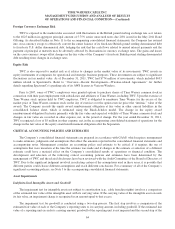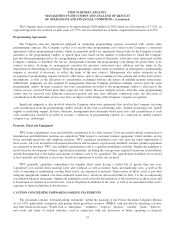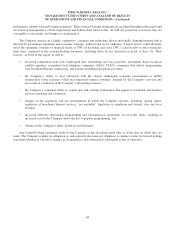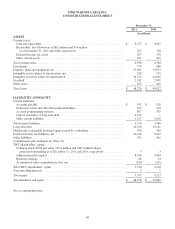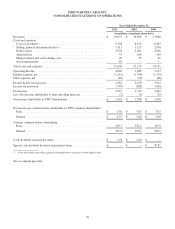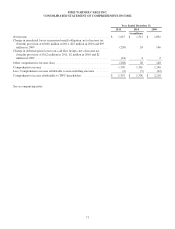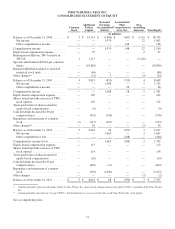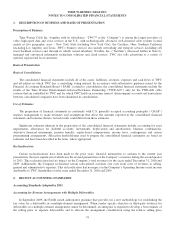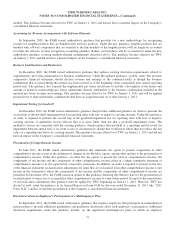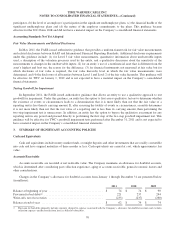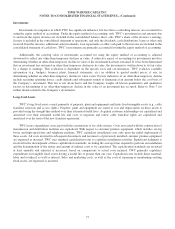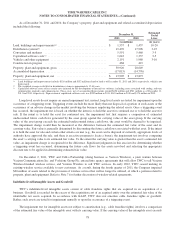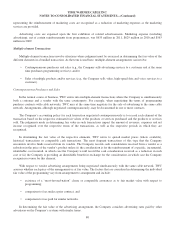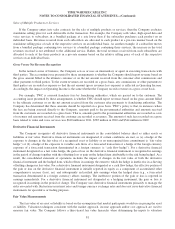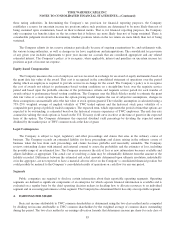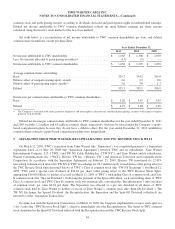Time Warner Cable 2011 Annual Report Download - page 82
Download and view the complete annual report
Please find page 82 of the 2011 Time Warner Cable annual report below. You can navigate through the pages in the report by either clicking on the pages listed below, or by using the keyword search tool below to find specific information within the annual report.TIME WARNER CABLE INC.
NOTES TO CONSOLIDATED FINANCIAL STATEMENTS
1. DESCRIPTION OF BUSINESS AND BASIS OF PRESENTATION
Description of Business
Time Warner Cable Inc. (together with its subsidiaries, “TWC”®or the “Company”) is among the largest providers of
video, high-speed data and voice services in the U.S., with technologically advanced, well-clustered cable systems located
mainly in five geographic areas – New York State (including New York City), the Carolinas, Ohio, Southern California
(including Los Angeles) and Texas. TWC’s business services also include networking and transport services (including cell
tower backhaul services) and, through its wholly owned subsidiary, NaviSite, Inc. (“NaviSite”) (discussed further in Note 6),
managed and outsourced information technology solutions and cloud services. TWC also sells advertising to a variety of
national, regional and local customers.
Basis of Presentation
Basis of Consolidation
The consolidated financial statements include all of the assets, liabilities, revenues, expenses and cash flows of TWC
and all entities in which TWC has a controlling voting interest. In accordance with authoritative guidance issued by the
Financial Accounting Standards Board (“FASB”) related to consolidation, the consolidated financial statements include the
results of the Time Warner Entertainment-Advance/Newhouse Partnership (“TWE-A/N”) only for the TWE-A/N cable
systems that are controlled by TWC and for which TWC holds an economic interest. Intercompany accounts and transactions
between consolidated companies have been eliminated in consolidation.
Use of Estimates
The preparation of financial statements in conformity with U.S. generally accepted accounting principles (“GAAP”)
requires management to make estimates and assumptions that affect the amounts reported in the consolidated financial
statements and footnotes thereto. Actual results could differ from those estimates.
Significant estimates inherent in the preparation of the consolidated financial statements include accounting for asset
impairments, allowances for doubtful accounts, investments, depreciation and amortization, business combinations,
derivative financial instruments, pension benefits, equity-based compensation, income taxes, contingencies and certain
programming arrangements. Allocation methodologies used to prepare the consolidated financial statements are based on
estimates and have been described in the notes, where appropriate.
Reclassifications
Certain reclassifications have been made to the prior years’ financial information to conform to the current year
presentation, the most significant of which was the revised presentation of the Company’s revenues during the second quarter
of 2011. This reclassification had no impact on the Company’s total revenues for the years ended December 31, 2010 and
2009. Additionally, the Company reclassified certain sales-related customer care costs from costs of revenues to selling,
general and administrative expenses. This reclassification had no impact on the Company’s Operating Income or net income
attributable to TWC shareholders for the years ended December 31, 2010 and 2009.
2. RECENT ACCOUNTING STANDARDS
Accounting Standards Adopted in 2011
Accounting for Revenue Arrangements with Multiple Deliverables
In September 2009, the FASB issued authoritative guidance that provides for a new methodology for establishing the
fair value for a deliverable in a multiple-element arrangement. When vendor specific objective or third-party evidence for
deliverables in a multiple-element arrangement cannot be determined, an enterprise is required to develop a best estimate of
the selling price of separate deliverables and to allocate the arrangement consideration using the relative selling price
74


